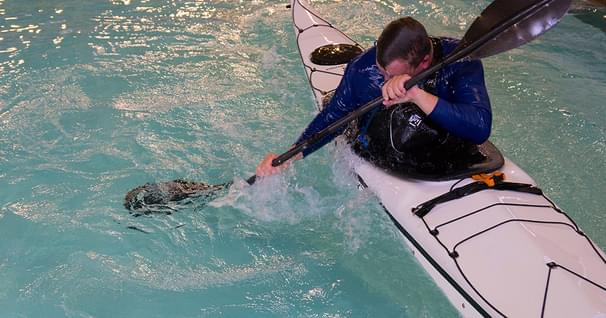Escape from Kayak Attitude
As a kayak instructor I want to know if my students can wet exit from their kayak. I am sure my students want to know they can wet exit from their kayak when they capsize. It is common practice to teach and practice wet exits near the start of a beginner's class. Not only is it a necessary skill it also beneficial for everyone's piece of mind.
Over the years I have noticed a state of mind with many kayakers. I call it the "Escape From Kayak" attitude. Some kayakers frantically exit their kayak due to a dislike for being submerged and upside down. Others automatically wet exit upon capsizing just because that is all they have learned to do. Since a wet exit is usually taught from the onset it makes sense that the default action is a wet exit.
Many years ago I heard of an instructor (Tom Long) who taught his students to do a wet entrance as their first skill. I thought it was a brilliant idea. I immediately began thinking of numerous advantages when using this approach. When I began incorporating this skill I noticed a greater relaxation amongst my students after performing this skill. It also set a foundation for more advanced skills. After performing a wet entrance a wet exit is no big deal.
The more time I spend working with kayakers, in a variety of conditions, I see kayakers wet exiting too often and too soon. The result is greater exposure to the conditions for the swimmer and a lot more energy output for the paddlers assisting. If there is no-one assisting, then more energy is expended by the solo paddler too. If those paddlers would have stayed in their kayak a little longer then some help could have been there thus avoiding a wet exit. I call staying in your kayak while submerged as "hang time".
More options become available the longer the hang time. An Eskimo recovery is one of the frequently used methods for assisting a capsized kayaker. If there were a solid support nearby (dock, kayak, rock, piling, buoy, etc.) the submerged kayaker could swim with their kayak to the support and right themselves. If you can get comfortable coming up for air and taking a breath while still in your cockpit you can increase your hang time.
Being comfortable when upside down in your kayak is essential when learning how to roll. It is also necessary for performing any of the skills mentioned above. Learning how to do a wet re-entry is a skill that can help you relax after capsizing. It is also a necessary component of the following skills:
- Wet re-entry and roll
- Wet re-entry and paddle float roll
- Wet re-entry and Eskimo recovery (bow or paddle)
- Wet re-entry and Hand of God recovery
Due to the water supporting your body weight these re-entry options take a lot less energy than climbing back on top of your kayak.
I learned a skill from my kayak surfing days. On more than one occasion after getting knocked over by a wave I was still in my kayak when the next whitewater wave was upon me. As the wave hit the kayak I stayed in the kayak and was sent side surfing toward shore while submerged. I learned how to brace in the direction of the wave from a submerged position and used the support of the wave to brace/roll myself up. I call it a brace/roll because the force of the whitewater wave lifted the paddle while I was in my high brace position and the next thing I knew I was right side up. A sculling brace can also be used in this circumstance. It is extremely important to use proper high brace techniques to protect your shoulders from injury when trying this skill. Remember to keep those elbows below the height of the shoulder and don't reach too far out with the brace.
Another option, if you are equipped accordingly, is using the Back-Up/Rollaid device. If your roll isn't working and there are no other righting options then using the inflatable bag gives you the support to right yourself.
All of the options mentioned above are only possible if you are in your kayak when it is submerged. You can either stay in your kayak or re-enter it. In either case you cannot have that "escape from kayak" attitude. I urge you to practice increasing your hang time. Learning a wet re-entry is one of the ways of adding to your options.
Another common practice taught by many instructors is banging three times on the bottom of your kayak before wet exiting to show you are relaxed. While this is a good technique it still leads to a wet exit. I encourage you to not only bang on the bottom of your kayak (which is the first part of the Eskimo recovery) try swimming with your kayak after the capsize. Try coming up for a breath of air by pushing down with your hands to get your head up to increase your hang time. If you know how to roll another drill you can try is throwing your paddle to the side, capsize, swim to your paddle and use the paddle to roll up. This is a definite indicator you have a reliable roll.
A wet exit is necessary in kayaking. However, I don't believe it should be your first option. I like to think of the wet exit as a technique to use when I have explored all my other stay in kayak options. If you do wet exit try to do it under control and remember to never loose contact with you paddle and kayak.
Wayne Horodowich, founder of The University of Sea Kayaking (USK), writes monthly articles for the USK web site. In addition, Wayne has produced the popular "In Depth" Instructional Video Series for Sea Kayaking.
Related Articles
Dungeness Spit from above, with the New Dungeness Lighthouse in the distance Dungeness…
Whether you were new to paddling in 2018 or you're an experienced paddler, you can never stop learning.…
Mention “pool session” and the first image that pops into most kayakers minds is a class in how to roll.…
What's the best way to quiet a novice paddling class? Mention the "Eskimo Roll." Nothing worries…



